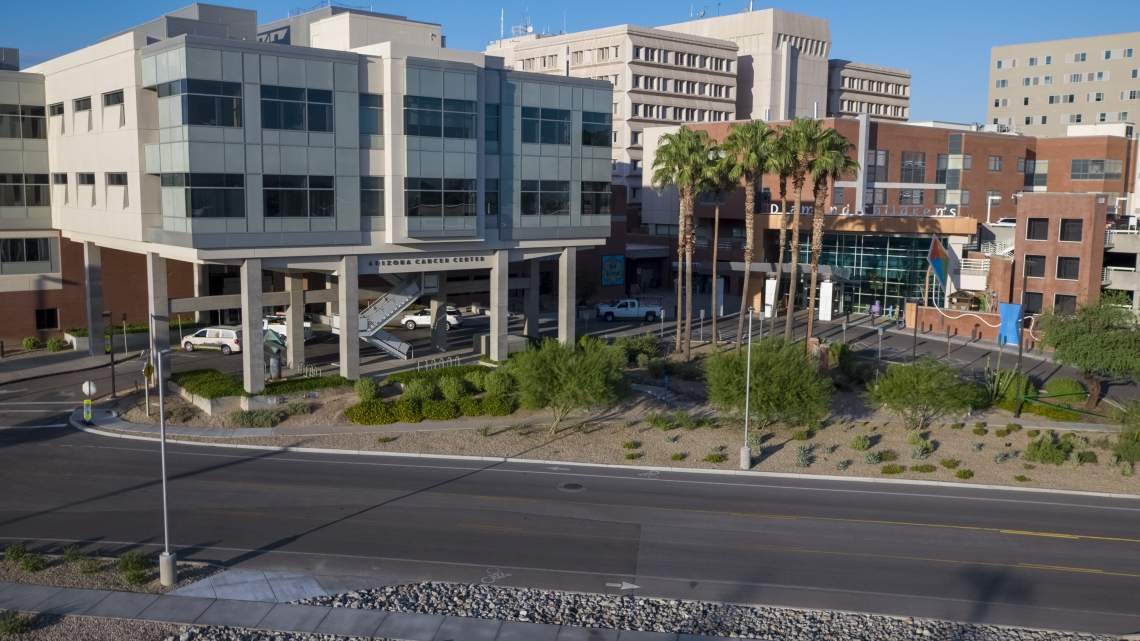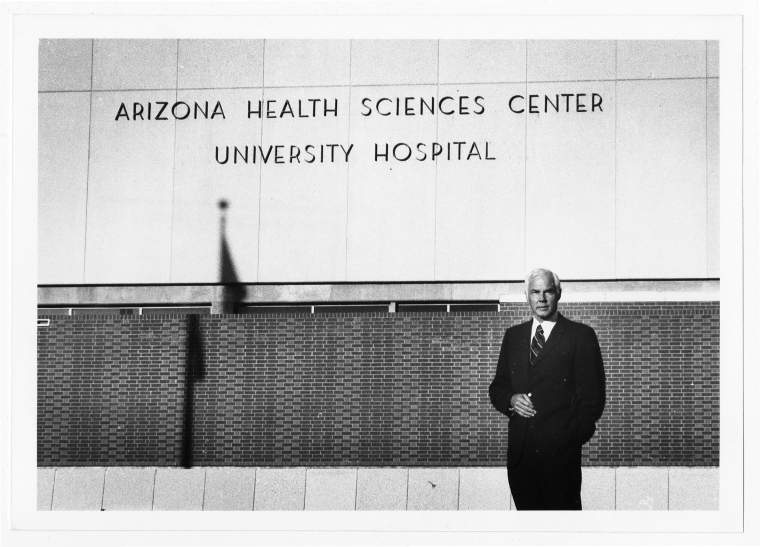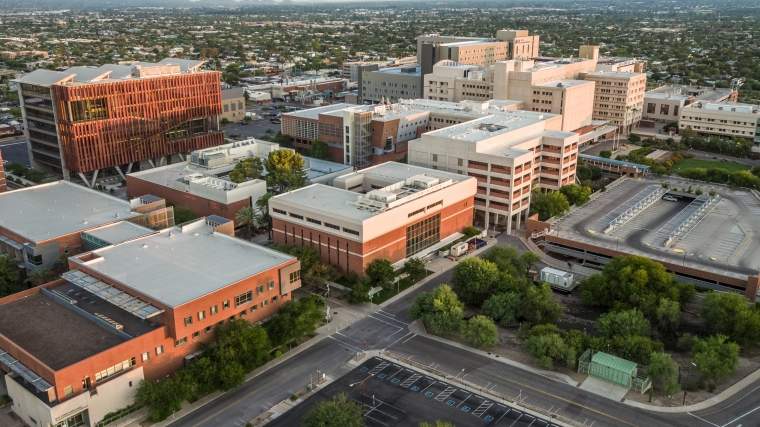University of Arizona Health Sciences has come a long way since the College of Medicine's founding in 1967 and is uniquely poised to help address Arizona's long-term health care needs, President Robert C. Robbins said in a presentation to the Arizona Board of Regents.

Banner – University Medical Center Tucson is the University of Arizona's teaching hospital, and a nationally recognized health care facility. (Noelle Haro-Gomez and Kyle Mittan, University of Arizona)
By Logan Burtch-Buus, University Communications | April 21, 2023
Improving the health and wellness of all Arizonans begins with groundbreaking research and treatment taking place every day at University of Arizona Health Sciences, university President Robert C. Robbins told the Arizona Board of Regents Thursday.
During ABOR's meeting on the UArizona campus, Robbins discussed the state's long-term health care and biosciences needs, and how to best leverage and optimize the university's health sciences assets to address those needs.
"We have a world-class research university that, over the last 60 years that health sciences have been in Tucson, has grown to make collaborations across colleges – and I think we're uniquely positioned as well," Robbins said. "We're the only Association of American Universities, land-grant, Hispanic-Serving Institution with more than 20,000 students; two medical schools; colleges of nursing, public health and pharmacy; and a veterinary school. The presence of those assets is truly unique and is a model for delivering an innovative care system throughout the state of Arizona."
 Dr. Merlin K. "Monte" DuVal, founding dean of the University of Arizona College of Medicine, stands in front of the University of Arizona Health Sciences Center. (University of Arizona)
Dr. Merlin K. "Monte" DuVal, founding dean of the University of Arizona College of Medicine, stands in front of the University of Arizona Health Sciences Center. (University of Arizona)
The university admitted its first College of Medicine class in fall 1967 under the visionary leadership of founding college dean Merlin K. DuVal. Four years later, the university opened its teaching hospital, now known as Banner – University Medical Center Tucson.
Today, the College of Medicine – Tucson is one of several colleges, research centers and institutes under the umbrella of University of Arizona Health Sciences, considered a statewide leader in biomedical research and training for health care professions. UArizona Health Sciences also includes the College of Medicine – Phoenix, College of Nursing, Mel and Enid Zuckerman College of Public Health, R. Ken Coit College of Pharmacy and more than a dozen research centers and programs focused on cancer, neurodegenerative diseases, pain and addiction, respiratory diseases, biomedical informatics, health technology innovation, health disparities, precision health care and pandemic preparedness.
While the university has seen great success in the development of its health sciences programs, the state of Arizona is facing a growing health care crisis, Robbins said.
Last fall, the Board of Regents investigated the long-term health workforce needs in Arizona. The board found that not only is the state's worker-to-population ratio below the national average for almost all health care-related professions, but Arizona also has fewer hospital beds per population than national averages. Arizona needs thousands of additional nurses, doctors and other health professionals to close existing gaps, and the state's rural communities are experiencing even greater hardships, the investigation found.
To help combat the health care crisis, Robbins said the university relies on teaching, discovery and care to create a strong foundation of treatment for today's patients and to train the next generation of professionals with an interdisciplinary approach.
Robbins also mentioned exciting new developments for the university, including the under-construction Pima Joint Technical Education District's new Mel & Enid Zuckerman Center for Health and Medical Careers at the UArizona Tech Park at The Bridges. The innovative high school, developed in collaboration with the University of Arizona, will train and encourage local students to pursue careers in health sciences.
Robbins added that translating discovery to treatment and training the next generation of health care professionals help fulfill the vision DuVal set forth when he founded the college of medicine: to create a healthier Arizona for all its residents.
 University of Arizona Health Sciences now includes several colleges and more than a dozen research centers and programs. (Noelle Haro-Gomez and Kyle Mittan, University of Arizona)
University of Arizona Health Sciences now includes several colleges and more than a dozen research centers and programs. (Noelle Haro-Gomez and Kyle Mittan, University of Arizona)
The benefit of the work being done at UArizona Health Sciences may not be limited to Earth, however. Robbins said the university is also uniquely positioned to leverage its wealth of astronomy expertise, alongside its health care expertise, to improve health and wellness outcomes for those involved in NASA missions.
"We will improve the health and wellness of humanity one patient, one community, one county at a time," he said. "We will create a beacon for health, healing and science. We will convert cancer to a chronic, manageable disease, and we will serve as pioneers for space health. Our overarching vision over the next 40 years, as I see it, is to advance the frontiers of health and wellness in Arizona and beyond, and to be a model for other states and counties for how you can use an academic medical center for fundamental discovery and translate those discoveries into treatments to improve the health of individuals and the community."
President Robbins Presentation to ABOR April 20, 2023
![]() ABOR Presentation 042023_PRINT v2.pdf
ABOR Presentation 042023_PRINT v2.pdf
During the Arizona Board of Regents' meeting on the UArizona campus April 20, President Robert C. Robbins discussed the state's long-term health care and biosciences needs, and how to best leverage and optimize the university's health sciences assets to address those needs.

